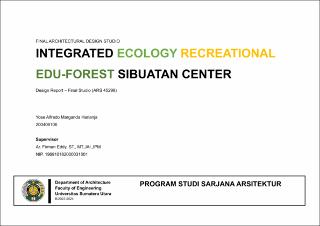Integrated Ecology Recreational Edu-Forest Sibuatan Center

Date
2024Author
Harianja, Yose Alfredo Marganda
Advisor(s)
Eddy, Firman
Metadata
Show full item recordAbstract
The tourism sector has become a crucial pillar in Indonesia's economy, especially in the Sibuatan Forest Area, Merek Subdistrict, Karo
Regency. However, there are challenges, such as ecosystem degradation leading to increased carbon emissions and a lack of knowledge
and awareness among the public regarding the conservation of the protected forest environment. To address these issues, a holistic solution
is introduced through the design of recreational facilities encompassing aspects of ecotourism, education, and aligned with the principles of
ecological architecture.
The purpose of these facilities is to protect and optimize the use of the protected forest area while providing inspiration, education, and
sustainable local economic opportunities, with the goal of achieving harmony between humans and nature. The design study of recreational
facilities in this forest is crafted using an ecological architecture theme. The selection of this approach is considered for its ability to
harmoniously integrate buildings with the surrounding environment, while still adhering to sustainability principles and ecological balance.
The ecological architecture theme also provides opportunities to utilize environmentally friendly building materials and green technology,
supporting efforts towards carbon footprint reduction. Architectural aspects in the context of the forest involve selecting designs that minimize
environmental impact. The use of recycled materials and sustainable building technologies is integrated into the design to reduce overall
ecological footprint. Additionally, the recreational facilities will be designed with careful consideration of proper placement to avoid disturbing
the original ecosystem and biodiversity of the forest.
The design implications for the region and the community include enhancing tourism appeal through an educational and sustainable
ecotourism experience. This approach is also expected to raise local awareness of the importance of environmental conservation and create
new economic opportunities through participation in tourism activities. As a result, it is hoped that the community will experience the benefits
of environmental preservation efforts and sustainable economic development in the protected forest area.
Collections
- Profession of Architect [182]
